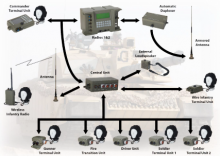Main communication requirements of armored vehicles are radio/s, intercommunication system, and duplexer. One of the main considerations of the vehicles is arranging these systems as well as their easy operation for commander. All of the mentioned equipment is considered as an integrated system as follows:
● Two radios in one case with proper dimension suitable to install inside every vehicle
● The abovementioned two radios can be controlled via a remote control unit
● In addition to the radios, Intercommunication system can be controlled via the remote control unit
There is no need to the operator for duplexer so that it is set automatically (considering status of the radios)
● Infantry unit can be operated as a wired/wireless unit
Radios are operated in VHF frequency band with capability of ciphering and frequency hopping as well as transmitting/receiving voice and data.
Up to 6 crews can be supported by the intercommunication system. In addition it can announce alarm sensors of the vehicle.
Radios of the system can be operated stationary as well as retransmission station
Capabilities
● Including two VHF-LB radios (in one case), intercommunication central unit, commander remote control panel, gunner terminal unit, 50 crew member terminal units, wireless/wire infantry terminal unit, automatic duplexer, and external loudspeaker l for controlling, setting, and displaying the system communication status and establishing voice communication between the commander and intercommunication central unit
● Connectable to one gunner, one driver, three crews, and one infantry
● Establishing wireless/wire communication with infantry
● Capability of establishing communication with automatic duplexer in case that an antenna is available on the vehicle
● Capability of installing on various types of armored vehicles
● Connectable to an external loudspeaker for propagating received voice from the radios
● Capability of turning ON/OFF the system completely via a key available on the commander remote control panel
● Capability of connecting vehicle’s sensors to the system and audio/visual displaying the activated sensors
● Capability of establishing intercommunication between the crews
● All of the crews can gain access to the radio 1 due to the commander authority
● Commander and gunner can gain access to the radios 1 and 2
● Capability of programming all of the system equipment externally
● Capability of filtering various noises created due to the vehicle
● Proper voice quality in all statuses
● Easy troubleshooting
● Easy operation
General specifications |
|
Frequency range | 30-87.9875MHz |
Number of frequency channels | tactical military operation |
Frequency channel spacing | 25KHz/12.5KHz |
Number of preset channels | 10 |
Type of communication | Simplex/Half-duplex |
Modulation type | FM (plain mode)/BFSK (cipher & FH mode) |
Input power supply | 24V |
Antenna type | Wideband (AT-3090) |
Antenna impedance | 50Ω |
Number of sub bands | 9 |
Hopping bandwidth | 6.4MHz |
Number of SMS memory | 8 (inbox) |
Transmitter specifications |
|
Output power | R1:40W,4W,0.25W/R2:4W,2W,0.1W |
Frequency stability | ±2PPM |
Pilot tone frequency | 150±2Hz |
Harmonic rejection | Better than 56dBc |
Current consumption | Less than 10A in H mode |
Distortion | Less than 7% |
Maximum PTT time | 3 minutes in active mode/no limit in inactive mode 4~6.5KHz (25KHz channel spacing) 2~3.25KHz (12.5KHz channel spacing) |
1KHz modulation deviation | |
Receiver specifications |
|
Sensitivity | -107dBm/12dB |
Distortion | Less than 7% |
Current consumption | 600mA |
IF (Intermediate Frequency) | Better than 70dB |
rejection |
|
Image frequency rejection | Better than 70dB |
Adjacent channel rejection | Better than 70dB |
Output audio level. | >2.5Vrms |
Squelch type | Noise/Tone |
Audio frequency response | 0.3~3KHz |
Mechanical specifications |
|
Dimensions (W×H×D | 340×200×220mm |
Weight | 9.5Kg |
Environmental specifications |
|
Operating temperature | -30°C ~ +65°C |
Storage temperature | -40°C ~ +70°C |
Standard | IDS-810 |
| Attachment | Size |
|---|---|
| chapter 6-11(31)_290.pdf | 613.43 KB |
| chapter 6-11(32)_291.pdf | 189.38 KB |


